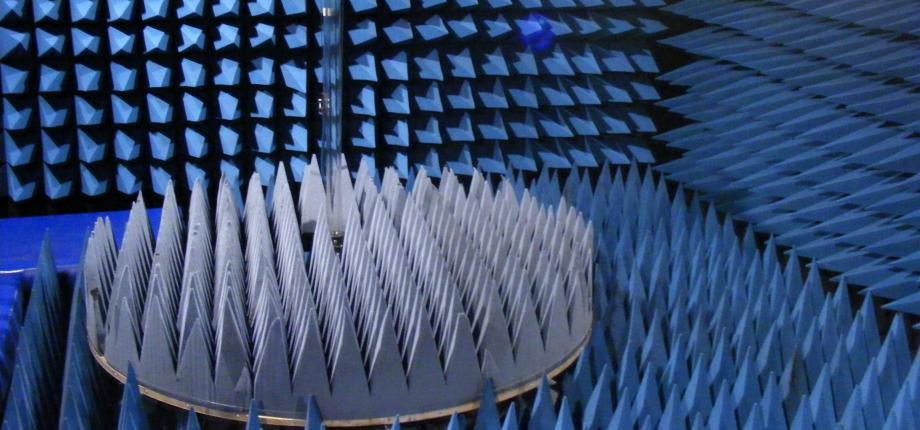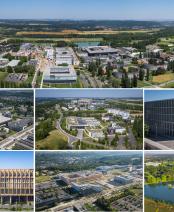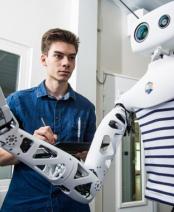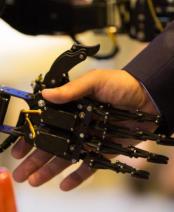Master Year 2 Radio Systems

| Year | Master Year 2 |
| Program | Radio Systems |
| ECTS Credits | 60 |
| Language | Courses are mostly taught in English (with a few exceptions in the 2nd quarter), and all documents are provided in English (or in French at the request of students). |
| Orientation | Industry or research |
| Location | Palaiseau Campus |
| Course duration | 12 months, full time |
| Course start | September |
| Degree awarded | Master’s degree |
WHY ENROLL IN THIS PROGRAM?
Asset n° 1
Pursue an engineering career in industry or a PhD
Asset n°2
Master radio and/or guided transmission systems. Have acquired the basic principles of new communication standards ( 5G and beyond).
Acquire practical experience through the realization of several projects and the end-of-study internship.
Asset n°3
Benefit from the expertise and know-how of professors and researchers from two schools and a major university, as well as their significant resources (in particular access to state-of-the-art professional equipment), and their collaborations and contacts with numerous companies and other academic institutions.
The Radio Systems M2 addresses the techniques of design of communication systems at various levels: Radiofrequency (RF) systems, architectures, functions and components. The cursus organization consists of lectures, tutorials, practical work, seminars and projects based on a significant personal involvement. The students evaluations are based on written exams, written reports and/or oral defenses.
The program covers the following topics: microwaves techniques used in RF front-ends of transmission systems, notably for communications, radio devices, propagation issues for system deployment, theory and practice of antennas, a knowledge of the main methods of numerical simulation in electromagnetism and propagation (circuits, antennas, propagation channel), associated with computation methods dedicated to specific applications (EMF exposure and dosimetry, localization), an overview of satellite link systems for communications, GNSS and TV broadcasting, the basics of radar, as well as a good understanding of the roles of the physical layer and of the current and emerging medium access methods, and their interactions.
Objectives
- The students must acquire a mastery of radio and/or guided transmission systems implemented in the telecommunications, satellite or indoor localization, broadcasting, radar and other sectors, with particular emphasis on radio communications.
- Students will be made aware of emerging and future technologies to address the challenges of new services, new applications, requiring higher capacity, reduced latency, increased reliability, or low throughput but associated with other applications functionalities (localization, identification, etc.) and/or targeting a large number of terminals or sensors. It is therefore necessary to optimize the functions and architectures of the radio systems, in order to contribute to the overall optimization of the networks. The purpose of the M2 is to train engineers and researchers able to meet these challenges.
After graduation, students will be equipped to:
- Pursue a PhD
- Join a company as an engineer, mainly in the field of research and development, in the following sectors: high frequency electronics, telecommunications, aeronautics, automotive, embedded systems, space technologies, defense, electromagnetic measurement and metrology
Core courses
| Radio Microwave functions | 45 h 4 ECTS English |
Radio architecture and Physical layer and network interface | 45 h 4 ECTS English |
| Antennas and propagation channel | 30 h 3 ECTS English |
| Satellite communications systems | 30 h 3 ECTS English |
Positioning / goniometry / radio localisation & RADAR | 45 h 4 ECTS English/French |
| RF Instrumentation, measurement & EMC | 30 h 3 ECTS English |
| Research initiation project | 45 h 4 ECTS English |
Elective courses
Choice of courses: two choices of elective courses are offered to students in partnership with the CAT course of the University of Paris-Saclay (UPSaclay).
- Option 1: UE "Technologies for microwave and terahertz" instead of the UE " GNSS precise Positioning for drone and other applications”
- Option 2 : UE "Optical telecom systems" instead of UE "Emerging radio technologies - Dosimetry and interaction of waves with living organisms"
- Option 3: Choice of the two UPSaclay UEs previously mentioned (replacing the two SyR UEs)
Note: the cooperation of these UE with UPSaclay is reciprocal, the two above-mentioned UE of SyR being proposed to CAT students.
| 30 h 3 ECTS English |
| GNSS precise Positioning for drone and other applications | 30 h 3 ECTS English |
| Technologies for microwave and terahertz | 30 h 3 ECTS French |
| Optical telecom systems | 30 h 3 ECTS French |
Internship and thesis writing
4 to 6 months
Starting in March
30 ECTS
This internship can be carried out in a company or in a public or private research laboratory.
A report will be written and the internship will be defended in front of a jury made up of at least one member of the course jury and at least one member of the teaching staff (jury member or not).
The evaluation of the internship (N) will be based on the quality of the work (T) - taking into account the opinion of the internship tutor of the host organization -, the report (R) and the defense (S), according to the following weighting N = 0.5 T + 0.25 R + 0.25 S.
Study abroad
one semester: YES (Internship only)
Admission requirements
Academic prerequisites
- Completion of the first year of a Master in Electrical Engineering at Institut Polytechnique de Paris or equivalent in France or abroad
- Previous knowledge in the fields of electronics, microwaves, signal processing or digital communications is requires
Language prerequisites
Courses will be given in French and potentially in English. The language of instruction is specified in each module.
The level required from students is as follows:
- English: IELTS ≥ 6, TOEIC ≥ 785, CECRL ≥ B2
- French: CECRL ≥ B2
How to apply
Applications can be submitted exclusively online. You will need to provide the following documents:
- Transcript
- Two academic references (added online directly by your referees)
- CV/resume
- Statement of purpose
You will receive an answer in your candidate space within 2 months of the closing date for the application session.
Fees and scholarships
Registration fees are available here
Find out more about scholarships
Please note that fees and scholarships may change for the following year.
Applications and admission dates
Coordinators
Program office
General enquiries
The Radio Systems M2 addresses the techniques of design of communication systems at various levels: Radiofrequency (RF) systems, architectures, functions and components. The cursus organization consists of lectures, tutorials, practical work, seminars and projects based on a significant personal involvement. The students evaluations are based on written exams, written reports and/or oral defenses.
The program covers the following topics: microwaves techniques used in RF front-ends of transmission systems, notably for communications, radio devices, propagation issues for system deployment, theory and practice of antennas, a knowledge of the main methods of numerical simulation in electromagnetism and propagation (circuits, antennas, propagation channel), associated with computation methods dedicated to specific applications (EMF exposure and dosimetry, localization), an overview of satellite link systems for communications, GNSS and TV broadcasting, the basics of radar, as well as a good understanding of the roles of the physical layer and of the current and emerging medium access methods, and their interactions.
Objectives
- The students must acquire a mastery of radio and/or guided transmission systems implemented in the telecommunications, satellite or indoor localization, broadcasting, radar and other sectors, with particular emphasis on radio communications.
- Students will be made aware of emerging and future technologies to address the challenges of new services, new applications, requiring higher capacity, reduced latency, increased reliability, or low throughput but associated with other applications functionalities (localization, identification, etc.) and/or targeting a large number of terminals or sensors. It is therefore necessary to optimize the functions and architectures of the radio systems, in order to contribute to the overall optimization of the networks. The purpose of the M2 is to train engineers and researchers able to meet these challenges.
After graduation, students will be equipped to:
- Pursue a PhD
- Join a company as an engineer, mainly in the field of research and development, in the following sectors: high frequency electronics, telecommunications, aeronautics, automotive, embedded systems, space technologies, defense, electromagnetic measurement and metrology
Core courses
| Radio Microwave functions | 45 h 4 ECTS English |
Radio architecture and Physical layer and network interface | 45 h 4 ECTS English |
| Antennas and propagation channel | 30 h 3 ECTS English |
| Satellite communications systems | 30 h 3 ECTS English |
Positioning / goniometry / radio localisation & RADAR | 45 h 4 ECTS English/French |
| RF Instrumentation, measurement & EMC | 30 h 3 ECTS English |
| Research initiation project | 45 h 4 ECTS English |
Elective courses
Choice of courses: two choices of elective courses are offered to students in partnership with the CAT course of the University of Paris-Saclay (UPSaclay).
- Option 1: UE "Technologies for microwave and terahertz" instead of the UE " GNSS precise Positioning for drone and other applications”
- Option 2 : UE "Optical telecom systems" instead of UE "Emerging radio technologies - Dosimetry and interaction of waves with living organisms"
- Option 3: Choice of the two UPSaclay UEs previously mentioned (replacing the two SyR UEs)
Note: the cooperation of these UE with UPSaclay is reciprocal, the two above-mentioned UE of SyR being proposed to CAT students.
| 30 h 3 ECTS English |
| GNSS precise Positioning for drone and other applications | 30 h 3 ECTS English |
| Technologies for microwave and terahertz | 30 h 3 ECTS French |
| Optical telecom systems | 30 h 3 ECTS French |
Internship and thesis writing
4 to 6 months
Starting in March
30 ECTS
This internship can be carried out in a company or in a public or private research laboratory.
A report will be written and the internship will be defended in front of a jury made up of at least one member of the course jury and at least one member of the teaching staff (jury member or not).
The evaluation of the internship (N) will be based on the quality of the work (T) - taking into account the opinion of the internship tutor of the host organization -, the report (R) and the defense (S), according to the following weighting N = 0.5 T + 0.25 R + 0.25 S.
Study abroad
one semester: YES (Internship only)
Admission requirements
Academic prerequisites
- Completion of the first year of a Master in Electrical Engineering at Institut Polytechnique de Paris or equivalent in France or abroad
- Previous knowledge in the fields of electronics, microwaves, signal processing or digital communications is requires
Language prerequisites
Courses will be given in French and potentially in English. The language of instruction is specified in each module.
The level required from students is as follows:
- English: IELTS ≥ 6, TOEIC ≥ 785, CECRL ≥ B2
- French: CECRL ≥ B2
How to apply
Applications can be submitted exclusively online. You will need to provide the following documents:
- Transcript
- Two academic references (added online directly by your referees)
- CV/resume
- Statement of purpose
You will receive an answer in your candidate space within 2 months of the closing date for the application session.
Fees and scholarships
Registration fees are available here
Find out more about scholarships
Please note that fees and scholarships may change for the following year.














